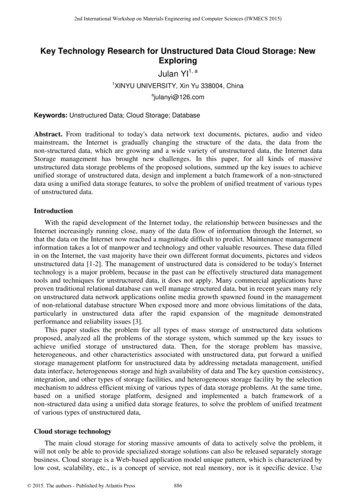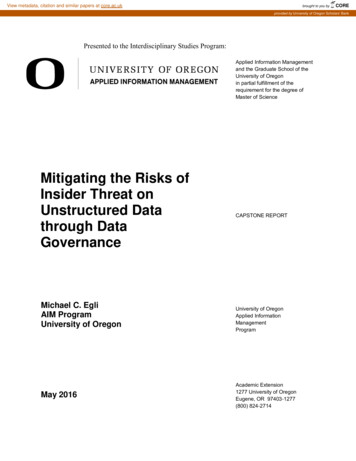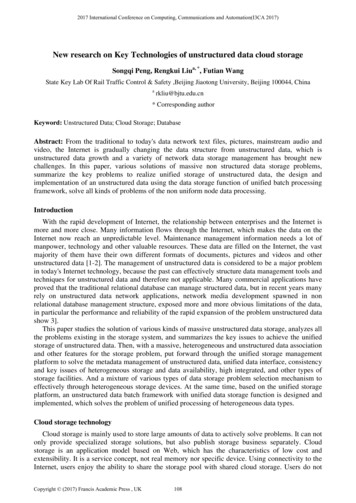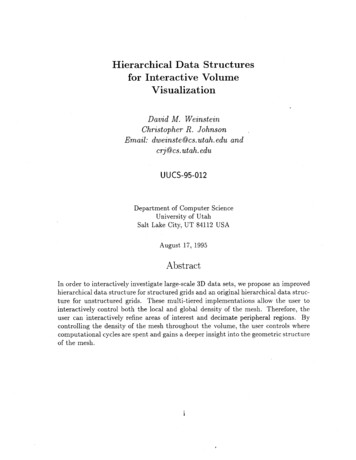
Transcription
2nd International Workshop on Materials Engineering and Computer Sciences (IWMECS 2015)Key Technology Research for Unstructured Data Cloud Storage: NewExploringJulan YI1, a1XINYU UNIVERSITY, Xin Yu 338004, Chinaajulanyi@126.comKeywords: Unstructured Data; Cloud Storage; DatabaseAbstract. From traditional to today's data network text documents, pictures, audio and videomainstream, the Internet is gradually changing the structure of the data, the data from thenon-structured data, which are growing and a wide variety of unstructured data, the Internet dataStorage management has brought new challenges. In this paper, for all kinds of massiveunstructured data storage problems of the proposed solutions, summed up the key issues to achieveunified storage of unstructured data, design and implement a batch framework of a non-structureddata using a unified data storage features, to solve the problem of unified treatment of various typesof unstructured data.IntroductionWith the rapid development of the Internet today, the relationship between businesses and theInternet increasingly running close, many of the data flow of information through the Internet, sothat the data on the Internet now reached a magnitude difficult to predict. Maintenance managementinformation takes a lot of manpower and technology and other valuable resources. These data filledin on the Internet, the vast majority have their own different format documents, pictures and videosunstructured data [1-2]. The management of unstructured data is considered to be today's Internettechnology is a major problem, because in the past can be effectively structured data managementtools and techniques for unstructured data, it does not apply. Many commercial applications haveproven traditional relational database can well manage structured data, but in recent years many relyon unstructured data network applications online media growth spawned found in the managementof non-relational database structure When exposed more and more obvious limitations of the data,particularly in unstructured data after the rapid expansion of the magnitude demonstratedperformance and reliability issues [3].This paper studies the problem for all types of mass storage of unstructured data solutionsproposed, analyzed all the problems of the storage system, which summed up the key issues toachieve unified storage of unstructured data. Then, for the storage problem has massive,heterogeneous, and other characteristics associated with unstructured data, put forward a unifiedstorage management platform for unstructured data by addressing metadata management, unifieddata interface, heterogeneous storage and high availability of data and The key question consistency,integration, and other types of storage facilities, and heterogeneous storage facility by the selectionmechanism to address efficient mixing of various types of data storage problems. At the same time,based on a unified storage platform, designed and implemented a batch framework of anon-structured data using a unified data storage features, to solve the problem of unified treatmentof various types of unstructured data,Cloud storage technologyThe main cloud storage for storing massive amounts of data to actively solve the problem, itwill not only be able to provide specialized storage solutions can also be released separately storagebusiness. Cloud storage is a Web-based application model unique pattern, which is characterized bylow cost, scalability, etc., is a concept of service, not real memory, nor is it specific device. Use 2015. The authors - Published by Atlantis Press886
connected to the Internet, users enjoy the ability to share cloud storage access storage pool. Usersdo not need to understand the content of the system, do not need to know how to store, for users ofall devices it is transparent, at any time and space a legitimate authorized users are able to use thenetwork to connect cloud storage, using cloud services [4-5]. Cloud storage data architecture modelshown in Figure 1.Figure 1. The architecture of cloud data storage service.With the rapid development of modern information technology network, the data amount ofinformation is growing exponentially, in the era of the formation of large-scale data, users generatea higher demand for storing data in a cloud environment for users to store data needs to address: (1)efficient storage and access massive data requirements, user appears every month up to hundreds ofmillions of dynamic, in a relational database using SQL query billions of data records table,inefficient, big data at times, the urgent need to solve the problem for efficient storage and accesslarge amounts of data; positive development; (2) high concurrent read and write databaserequirements, Internet, Web emphasis on the user as the center, according to the user personalizedinformation needed to generate dynamic pages and information, such as The current micro-Bo, thisapplication form a high concurrent access to data load requirements, usually formed tens ofthousands of times per second read and write demand; (3) high availability and scalability ofdatabase requirements, Web-based architecture , it is difficult to extend the database level, when arapid increase in the amount of users and access to the database server cannot simply takeadvantage of hardware and service node scalability and load balancing, some of the requirementsfor the site to provide uninterrupted service in terms of maintenance and upgrade form Stop andmigration data, will reduce the user experience: C4) support for handling unstructured datarequirements, relational database significantly constrains the processing of data and data types,cannot be achieved in the future user requirements for various data types.Unstructured data cloud storage hierarchyUnstructured data storage use is very common, many systems will have to upload attachments,images, press releases and document management functions. However, most of the currentimplementation is by creating a writable directory on the server to store. Unstructured data is oftenrelatively large, it will take up more bandwidth and a certain server computing power, which hassome influence on some of the high performance requirements of servers. Server clustersynchronization. When the application needs to scale clustering support, the traditional way willencounter more challenges. In order to synchronize data between the nodes within each server, weneed some similar sort of network storage technology to solve. Many servers are invaded by Trojanuploaded to the server implementation, and most of these implementations is because thevulnerability upload files generated. Traditional file system storage requirements for unstructureddata must be a directory of the file system is writable [6-7]. Cloud storage is not required, to use,and other methods can achieve similar functionality, but technically advanced cloud storage hascertain advantages. Cloud storage in the form of object storage for storing and reading in charge ofthe actual content of the document. Cloud storage of high stretch, massive high reliability, duplicate887
files merge, will help improve the quality of storage service. Unstructured data cloud storagearchitecture built on this design, the hierarchy shown in Figure 2.Unstructured dataVideo monitoringand data storageMulti-user onlinestorage serviceEnterprise dataservicesSoftware downloadserviceUnstructured dataaccess clusterApplication layerUsermanagementAccessauthorizationBLOB datamanagementSecurity policyMeta datamanagementSession layerData layerRouting layerRelational databasestorage clusterPhysical layerFigure 2. Cloud storage tier architecture of unstructured dataApplication layer provides unstructured data application interfaces, these interfaces varioustypes of storage applications developed by the data storage service provider in displayed, such as avariety of online storage, network drives, video, data hosting and software download services. Atthis point, the user is faced with virtual, capacity can be infinitely scalable cloud storage space,without regard to the physical location of the storage space and data when the user submits the data.Session layer is responsible for user management, rights assignment, space allocation andstorage security policy, the layer depending on the security level, the development of differentsecurity programs to ensure data security.The role of the data layer is a unified management of unstructured data and metadata.Unstructured data volume level from MB to GB level, sizes, and its metadata information, such asdata identification, file length, type and other attribute information, the total length of no more than1 KB, the amount of data on the differences between the two. Thus, the different needs of BLOBdata and metadata is stored on the network bandwidth and computing resources should be used indifferent types of data storage policies. Thus, Figure 1 will be decomposed into BLOB data layerservice data storage area and a Metadata store. Routing layer is responsible for the cloud node,interoperability and storage path access interface and back-end storage devices calculations.Physical layer unstructured data storage provides storage space and computing resources, and isresponsible for maintaining physical path storage node. For the purposes of this system can makefull use of existing communication subnet and devices without the addition of further investmentsin hardware.Unstructured data cloud storage system structure designIn order to achieve effective management of unstructured data, many domestic and foreigncompanies or individuals be a lot of research. The most important management is divided into two:one is based on technology, semi-structured data to unstructured data conversion; the other isunstructured data to structured data conversion, data will eventually be stored in a relational888
database in. Unstructured to Structured Data Conversion mostly used the "unstructured data,structured data half a structured data" gradual conversion. Thus, the structure of the data obtainedthrough the conversion of its relational database storage and management. Based on the projectrequirements, the use of "unstructured data structured data half a structured data" gradualconversion method and further expand on its basis, the concept of the standard structure members toimplement the data structure of the file name conversion versatility introduction of templates tosave the converted file to extract the file metadata, create document templates, documents relatedtable to achieve the association unstructured data with structured data, as shown in 3 show. Systemconsists of database, file system, template libraries, file format definition module, metadataextraction module, template creation and management module, intermediate module datarepresentation and data conversion modules and other components. On the whole systemarchitecture is divided into three levels: the interface application layer, application logic layer, datastorage layer.File system (client)FTP serverApplication layerinterfaceLocal hostAccess the fileFile format definitionMetadata extractionTemplates create and manageSave templateApplication logiclayerIntermediate data representationTemplate libraryXML data conversionTemplate informationmanagementCreate tablestructureDocumenttemplate tableDocument theresults tableData storage layerFigure 3. Unstructured data cloud storage system structureInterface application layer provides a graphical interface to the user data conversion, through theapplication interface, users can use unstructured to structured data conversion related operations,without having to be concerned about the specific data conversion.Program logic layer consists of five functional modules of the system structure, work focusedon achieving business logic structured to unstructured data conversion system. Interface applicationlayer client file system after obtaining simulation output file, issue a request for data conversion,then, the application receives the request sent by the client, will need to convert the file is passed tothe data conversion module. After the module receives the file, depending on the file typeclassification to determine which program to use to convert. Then, five functional modules to work,extract metadata of the file, establish the appropriate document templates, and then implement theunstructured to semi-structured data conversion, the processed data is written to the simulationresults table in the database. Application and then convert the result back to the user, and promptsthe user whether the next data conversion, to finalize the whole process of data conversion.Data storage layer collection system used by the database table, such as document templates,documents associated table, the simulation results tables. Document templates, documentsassociated table needs to be created before the system is running. Data simulation result table is889
unstructured file data after converted structured data. After the data conversion is completed, thesystem will associate the relevant information into the file table.ConclusionBased on the analysis of unstructured data on the internet rapidly growing trend, introduces theresearch staff at home and abroad for unstructured data storage problems caused by the proposedsolutions, these solutions can solve the massive non-structural data storage problems, and to ensurethe expansion of the system. However, a variety of data types unstructured data, different data havedifferent storage characteristics, it remains an urgent problem that how can these different kinds ofunstructured data stored unity.This paper presents a unified storage platform outside of unstructured data to provide a unifiedmodel of unstructured data storage interface, the underlying combined and implemented fordifferent types of unstructured data across heterogeneous storage, while in this heterogeneousstorage infrastructure ensure high availability and consistency of data. Then combined on the basisof this storage platform on the frame of a batch of unstructured data architecture, making theprocess vast amounts of unstructured data in computing resources and storage resources can be fullyintegrated to achieve efficient data processing.References[1] Nicolae B. High throughput data-compression for cloud storage[M]//Data Management in Gridand Peer-to-Peer Systems. Springer Berlin Heidelberg, 2010: 1-12.[2] Calder B, Wang J, Ogus A, et al. Windows Azure Storage: a highly available cloud storageservice with strong consistency[C]//Proceedings of the Twenty-Third ACM Symposium onOperating Systems Principles. ACM, 2011: 143-157.[3] Prahlad A, Muller M S, Kottomtharayil R, et al. Performing data storage operations with acloud storage environment, including automatically selecting among multiple cloud storage sites:U.S. Patent Application 12/751,651[P]. 2010-3-31.[4] Zhang D W, Sun F Q, Cheng X, et al. Research on hadoop-based enterprise file cloud storagesystem[C]//Awareness Science and Technology (iCAST), 2011 3rd International Conference on.IEEE, 2011: 434-437.[5] Wang Q, Wang C, Ren K, et al. Enabling public auditability and data dynamics for storagesecurity in cloud computing[J]. Parallel and Distributed Systems, IEEE Transactions on, 2011,22(5): 847-859.[6] Wang C, Ren K, Lou W, et al. Toward publicly auditable secure cloud data storage services[J].Network, IEEE, 2010, 24(4): 19-24.[7] Lin H Y, Tzeng W G. A secure erasure code-based cloud storage system with secure dataforwarding[J]. Parallel and Distributed Systems, IEEE Transactions on, 2012, 23(6): 995-1003.890
The management of unstructured data is considered to be today's Internet technology is a major problem, because in the past can be effectively structured data management tools and techniques for unstructured data, it does not apply. . Cloud storage tier architecture of unstructured data . Application layer provides unstructured data .










